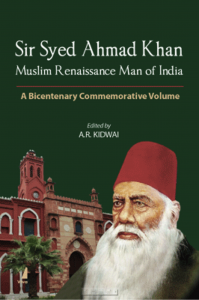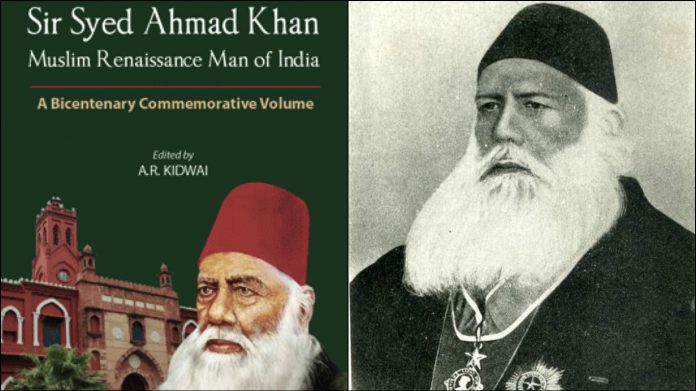A. R. Kidwai (ed), Sir Syed Ahmad Khan: Muslim Renaissance Man of India (A Bicentenary Commemorative Volume).
Name: Editor: AR Kidwai
Publishers: Viva Books. Delhi, 2017. Pages 338+xxviii.
Price Rs 1,895
By Mohammad Sajjad for Twocircles.net
While there remains lot of disagreement on whether the 19th century Indian awakening could be really termed as “renaissance”, there is no disagreement on the fact that “the nineteenth century was a very creative age…. [which] produced an unusually large number of distinguished men in different parts of [India]”, said Nemai Sadhan Bose (1931-2014), in his book, The Indian Awakening and Bengal (1960). Evaluating the role of Raja Rammohun Roy (1772-1833), he further said, “Like all other historical personages he had his limitations and fallibilities. But he occupies a unique position in the history of renascent India—as the harbinger of a new age”. This holds equally true of Syed Ahmad (1817-98) as well.
Nirad C Chaudhri (1897-1999) perceptively remarked that the Bengal “renaissance” was a feast to which the Muslims were not invited. It was left for Syed Ahmad, who, after around half a century, took the inspiration and set out on the path of similar reformism. Though his reformatory agenda in the religious and scriptural domain met with fierce resistance, just as faced by his Hindu predecessors in Bengal, his agenda for modern education attained increasingly greater success. It endures.

So far as the politics of nationalisms is concerned, Sir Syed may have believed more in the permanence of British rule (just as the Mughals who made India their home), but he and his companion litterateurs such as Altaf Hali (1837-1914), Shibli Nomani (1857-1914), and Deputy Nazir Ahmad (1831-1912) contributed a lot towards putting the community on the path of modernity. It instilled a cultural self-confidence and prepared a significant proportion of modern educated middle class among the corresponding class of the Muslims helping them overcome their sense of defeat at the hands of colonialism, and confronting it too.
To Partha Chatterjee (The Nation and Its Fragments, 1991), the literary outputs of Bankim Chandra Chatterjee (1838-94) contributed towards the first of the three phases of evolutionary nationalism, termed as “Moment of Departure”, wherein the Hindu ‘fragment’ of the Indian nation rediscovered largely forgotten Indian culture and tradition, and realising its superiority over the West in the domain of spiritual culture, it gained certain degree of confidence to challenge the colonial hegemony.
What about the Muslim ‘fragment’ of the Indian Nation in the 19th century?
In the historiography of Indian nationalism, the roles of Syed Ahmad and his companions/contemporaries such as Hali, Shibli, Deputy Nazir Ahmad have not been appreciated adequately in this specific perspective. Their travelogues, biographical and other writings worked wonders towards cross-cultural encounters. Thus the Muslim ‘fragment’ of the Indian nation has perhaps not been studied adequately in their, what Partha Chatterjee would say, “mutually conditioned historicities”
Historians have chosen to ignore such contributions. Thus, sections of historians measure the loyalty to the British rule exhibited by the “Moderates” of the Congress and that of by the likes of Sir Syed, with different scales. Interestingly, in such a scenario, people tend to forget the fact that the Aligarh Muslim University (AMU) symbolises Muslim response to modernity in South Asia. Jawaharlal Nehru, in his Discovery of India (1946), diagnosed that near absence of new middle classes among Mulims were impediment in the way of Indian nationalism in 19th century. R. C. Majumdar, et al, in their classic text-book, Advanced History of India, sort of elaborated, by saying, “It would hardly be an exaggeration to say that no single institution has done so much for a community as this college has done for the promotion of higher education and modern culture among the Muslims. Sir Syed was an ardent patriot and nationalist”. Gandhiji is also said to have like certain poems of Hali.
Syed Ahmad’s efforts contributed towards creation of middle class among India’s Muslims.
In short, a new historiography is needed for many aspects of the history of nineteenth century India. Those who tend to elevate Sir Syed to sainthood, as well as those who brand him as a harbinger of separate nationhood, (disturbingly corroborated by those on the other side of the border, who, in order to seek antiquity to their religion based exclusionary and therefore shaky nationhood), need to re-evaluate Sir Syed, keeping in mind all the limitations of the age, i.e. 19th century), as well as the context of colonialism and its power-play in the domain of culture and politics.
The anthology under review should be read and evaluated in this backdrop, even though neither the Foreword, by Farhan Nizami (Oxford), nor any other essay in the volume, really makes any such purported attempt. Though it does make a strong point about Syed Ahmad: “… his principal achievement is his understanding of the need to build intellectual spaces and frameworks of enquiry …”.
This anthology of 18 essays along with a Foreword has been brought out to commemorate the bicentenary of Syed Ahmad (1817-98). Among others, the contributors also include better-known scholars on Indian Islam and on Syed Ahmad such as Barbara Metcalf, David Lelyveld, Hafeez Malik.
Nonetheless, a conspicuous omission is of Gail Minault, Mushirul Hasan, S. Irfan Habib, Shamsur Rahman Faruqi (“From Antiquary to Social Revolutionary: Syed Ahmad Khan and the Colonial Experience”, Sir Syed Memorial Lecture, AMU, 2006), and Denis Wright (1989). Contributions of these five, besides at least an essay engaging with the critics of Sir Syed, could have enriched the volume quite immensely.
S. Irfan Habib, in his book, Jihad or Ijtihad: Religious Orthodoxy and Modern Science in Contemporary Islam (2012), demonstrates that the modern-day promulgation of Islam and its followers as ‘anti-modern’ and ‘anti-science’ is a myth that leads, quite literally, to explosives consequences.
It may sound ironical that, as yet, we don’t have comprehensive biographies of two great personalities, viz., Syed Ahmad, the founder of the Aligarh Muslim University, as well as Madan Mohan Malaviya (1866-1946), the founder of the Banaras Hindu University. Recently, Jagannath P. Mishra has published a good biographical account of Malaviya. It does, however, leave out certain significant aspects. (Dhrub Kumar Singh, “Retrieving the Political Malaviya” The Book Review December, 2016).
Mushirul Hasan’s essay, “Aligarh’s Notre eminent contemporain: Assessing Syed Ahmad Khan’s Reformist Agenda”, (EPW, May 9, 1998), could have gone very well with the objective of the anthology under review. Hasan, while addressing, the AMU alumni at the Royal Asiatic Society, London, on April 2, 1998, made some valid points, “As alumni of Aligarh University celebrate the centenary year of their founder this year, they face the uphill task of preparing the fraternity of teachers and students to meet the challenges of the next millennium. They need to complete Syed Ahmed’s unfinished agenda of fostering liberal and modernist ideas and take the lead in debating issues of education, social reforms and gender justice. They need to interpret Islam afresh in the light of worldwide intellectual currents and equip the Muslim brethren to cope with the harsh realities of life”. Inclusion of this essay could have enriched the anthology.
This volume under review has shied away from enlightening the readers on the issues of nationalism in late 19th century India. Even Hafeez Malik’s essay in this anthology does not touch this subject, though in 1966 he published an essay on Syed Ahmad’s contribution towards “Muslim Nationalism” (Islamic Studies, vol. 5, no. 4, December 1966, pp. 385-410). Denis Wright has argued in detail on this issue, in an essay (1989), “Sir Sayyid Ahmad Khan and the Indian National Congress” (Australian Journal of Politics and History, vol. 35, pages 364-73). Wright makes a point, “As a Muslim of principle, Sayyid Ahmad needed the reassurance of his own conviction, and while his novel reinterpretation of Islamic theology has not been regarded seriously by Muslims and non-Muslims alike, it helped him evolve political ideas which shaped Islamic consciousness in the 1880s. It would seem that in the period up to 1882, Sayyid Ahmad was a Muslim nationalist at heart, but his tendency to see the virtues of Hindu-Muslim cooperation was increasing. Certainly his admirers were not restricted to the British administration and press and those who shared his views, and nor were his charitable activities communal”. This essay therefore should have been included in this anthology.
As the political component stands largely excluded, this anthology does not say much on the trajectory of the All India Mohammedan Educational Conference (AIMEC, founded in 1886), nor does it engage with the United Patriotic Association.
Gail Minault’s essay, endorsed by David Lelyveld, has popularised a wrong view about Sir Syed that he was vehemently opposed to the idea of modern education to the women. The evidence cited by Minault is quite questionable. This is an aspect dealt with in detail by Shafey Kidwai, in his work (under progress) on certain aspect of Sir Syed’s reformism. This anthology however has chosen not to engage with the gender issue. Even though, Shafey Kidwai has contributed his essay in this volume, on a different subject of “Blasphemy and Conversion Debate and Sir Syed”. Here he makes a good point, “Sir Syed through his creative intuition and enquiring intelligence, protest narrative, rather than violent assaults, against blind adherence to ancestral beliefs, hatred, bigotry, discrimination, subjugation and intolerance”, which went to “redefine Islam in more ways than one” (emphasis added). Shafey Kidwai’s work under progress on Syed Ahmad, devoting a whole chapter on Syed Ahmad’s take on modern education to women, critiquing Minault, would be a welcome intervention.
In our times, religious extremism is becoming more and more violent. To dissuade such hot-headed elements, Amineh Hoti and Ataullah Siddiqui in their essays have tried to look up to Sir Syed’ s intellectual engagements with the issues of identity based conflicts. The essays of Charles Ramsey and Geoffrey Nash have also underlined the elements of pluralism in Syed Ahmad’s interventions and initiatives.
Recently, hitherto subordinated social groups of Muslims, now designated and popularised as “Pasmanda (Ajlaf and Arzal)” have registered their political assertion against Ashraf. In their articulations, they subject Syed Ahmad to criticism for having made some “contemptuous” remarks against the subaltern Muslim identities. However, the “Pasmanda Movement” should try learning one thing from Syed Ahmad that mere political consolidation will not take them too far. The agenda of educational uplift and social reform should not be excluded from their efforts for empowerment and social justice.
This volume seems to have been brought out little hastily. It does not include subject index. Given the fact that it is an anthology, its price has been put at a rather higher end.
In fact, a long introductory essay, incorporating above-mentioned omissions could have possibly dispensed with the inclusion of some of the essays suggested (to be included) in the anthology. One hopes in the next revised and enlarged edition these omissions will be taken care of.
The author is an Associate Professor at the Centre of Advanced Study in History, Aligarh Muslim University.


